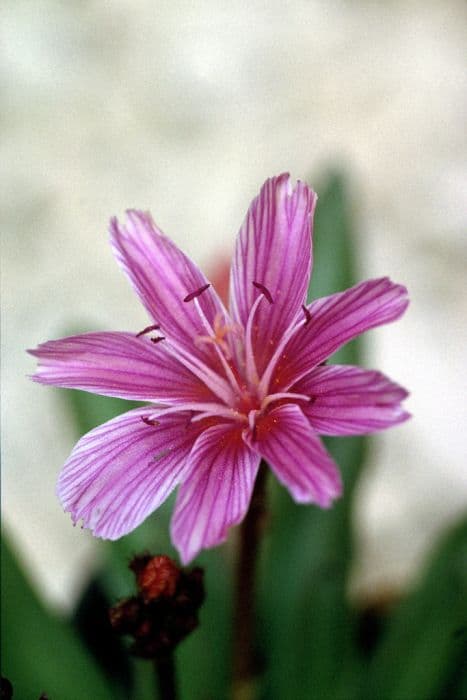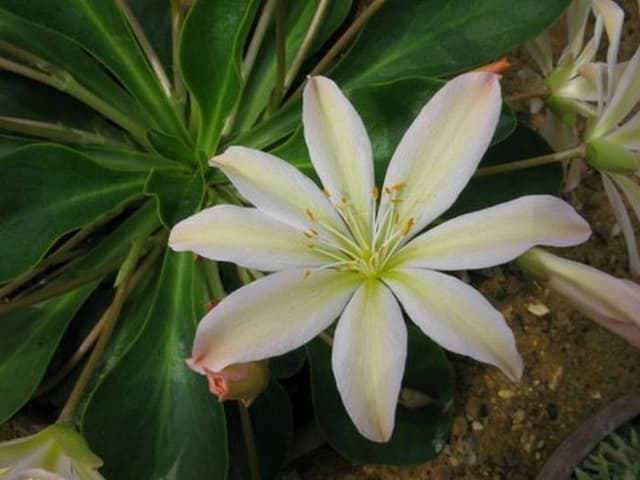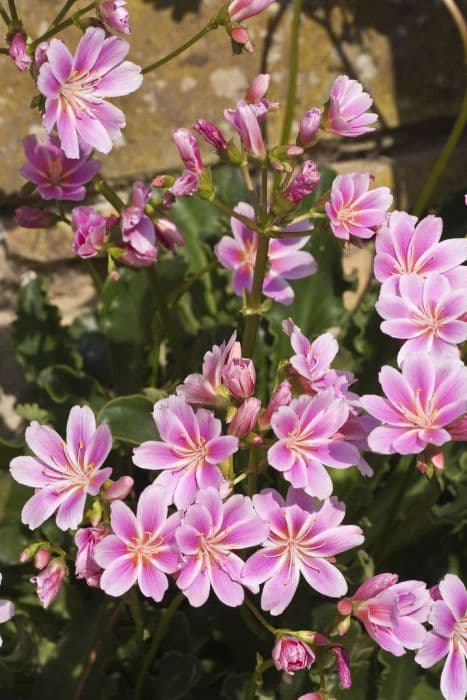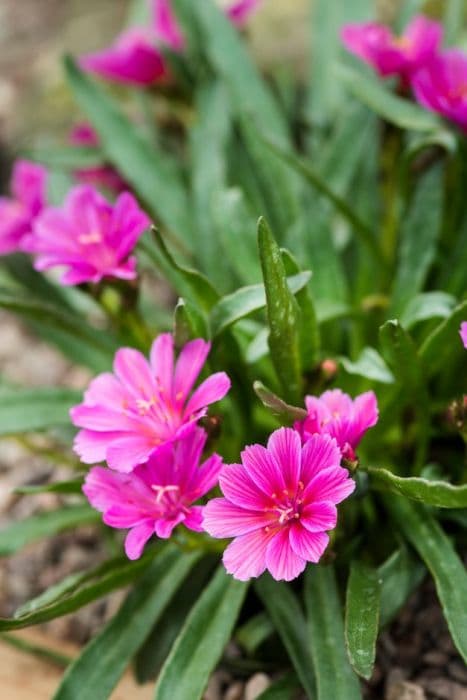Bitterroot Lewisia 'Little Plum' (Little Series)

ABOUT
Lewisia 'Little Plum' is a charming flowering plant known primarily for its striking bloom display and attractive foliage. The spade-shaped leaves are fleshy and juicy in appearance, forming a neat rosette close to the ground. The surface of the leaves may have a frosted or waxy look, which can catch dew and glisten in the morning sunlight. The star attraction of Lewisia 'Little Plum' lies in its profuse blossoms. The flowers are borne on short stalks that hover just above the foliage. Each bloom is composed of a circle of petals that range in color from a soft pink to a rich rose, often with subtle gradients and patterns that evoke an image of watercolor art. The center of the flower is typically a deeper, more intense hue, sometimes appearing as if it were dabbed by an artist's brush. The petals have a delicate, almost translucent quality, which can give the flowers a glow when they catch the light just right. Additionally, the blooms may be underscored by faint veins of a darker color, providing depth and complexity to the flower's aesthetic. These petals surround a bouquet of stamens, with their pollen-laden anthers providing a point of contrast. When in full bloom, the plant presents a carpet of color, creating a visually appealing impact that adds a touch of whimsy to gardens, rockeries, or containers where it is most commonly grown. Its blossoming period is a time of vibrancy that invites close inspection and rewards those who take a moment to appreciate the intricate beauty of this delightful plant.
About this plant
 Names
NamesFamily
Montiaceae
Synonyms
Bitterroot, Siskiyou Lewisia, Cliff Maids
Common names
Lewisia 'Little Plum' (Little Series)
 Toxicity
ToxicityTo humans
Lewisia 'Little Plum' is not commonly listed as a toxic plant to humans. If it were toxic, typical symptoms of plant poisoning might include nausea, vomiting, diarrhea, skin irritation, or allergic reactions, depending on the plant and its specific toxins. However, in the case of Lewisia 'Little Plum', there are no widely reported toxic elements that would cause poisoning if ingested by humans. As with any plant, individuals sensitive to particular botanical species may still experience reactions, but this is not indicative of widespread toxicity.
To pets
Lewisia 'Little Plum' is also not typically known to be toxic to pets. If it were, signs of toxicity might include vomiting, diarrhea, drooling, lethargy, or abnormal behavior, which are common symptoms associated with the ingestion of poisonous plants by animals. But since Lewisia 'Little Plum' is not listed as a toxic plant, it would generally be considered safe for pets. Nevertheless, it is always prudent to keep an eye on pets and prevent them from eating plants, as individual animals may have unique sensitivities or could experience gastrointestinal upset from eating non-food items.
 Characteristics
CharacteristicsLife cycle
Perennials
Foliage type
Evergreen
Color of leaves
Green
Flower color
Pink
Height
0.66 feet (20 cm)
Spread
1 feet (30 cm)
Plant type
Herb
Hardiness zones
5
Native area
North America
Benefits
 General Benefits
General Benefits- Ornamental Appeal: Adds vibrant color and texture to rock gardens, borders, or containers with its attractive evergreen foliage and vivid pink flowers.
- Low Maintenance: Requires minimal care once established, making it suitable for gardeners of all skill levels.
- Drought Tolerance: Once established, it shows good resistance to drought, reducing the need for frequent watering and is particularly suited for xeriscaping.
- Compact Size: Its small stature makes it an excellent choice for small spaces or as a ground cover without overwhelming other plantings.
- Cold Hardy: Capable of surviving in cooler climates and can withstand frost, making it a robust choice for many gardens.
- Attracts Pollinators: The flowers are attractive to bees and butterflies, promoting biodiversity in the garden.
- Long Blooming: Offers a prolonged display of blossoms from late spring into summer, providing extended interest and color.
- Deer Resistant: Less palatable to deer, which can help prevent damage to the plant in areas where deer browsing is a problem.
 Medical Properties
Medical PropertiesThis plant is not used for medical purposes.
 Air-purifying Qualities
Air-purifying QualitiesThis plant is not specifically known for air purifying qualities.
 Other Uses
Other Uses- Lewisias are often used as components in alpine or rock garden designs, as they are well-suited for growing in crevices and among rocks where their intricate flowers can be admired up close.
- These plants can be employed as part of a living roof or green roof installation, especially in areas where low maintenance and drought resistance are priorities.
- Lewisias, with their colorful blooms, can serve as a natural food dye source for crafts such as fabric dyeing or for use in natural pigments.
- With their compact growth habit, they can be used in fairy gardens to create a whimsical miniature landscape.
- This plant's vibrant flowers can be used to create attractive and natural-looking floral arrangements for table settings and events.
- Lewisia 'Little Plum' can be grown in containers on balconies or patios to add color and interest to small outdoor living spaces.
- Photographers may utilize these plants as subjects or as part of a composition in botanical photography due to their distinctive appearance.
- They are occasionally used as a natural indicator of seasonal change in educational settings, as their flowering period aligns with specific times of the year.
- Artists can take inspiration from Lewisia 'Little Plum' colors and patterns in painting, drawing, or other visual arts.
- Gardeners sometimes use these plants as a tool to teach about soil types and drainage, as Lewisias require well-draining soil and can help illustrate proper gardening techniques for such conditions.
Interesting Facts
 Feng Shui
Feng ShuiLewisia is not used in Feng Shui practice.
 Zodiac Sign Compitability
Zodiac Sign CompitabilityLewisia is not used in astrology practice.
 Plant Symbolism
Plant Symbolism- Tenacity: Lewisia 'Little Plum' is known for its ability to thrive in rocky, mountainous habitats, symbolizing resilience and the strength to overcome adversity.
- Beauty in Adversity: With its delicate flowers blooming amidst harsh conditions, it represents the idea that beauty can be found even in difficult circumstances.
- Survival: This plant's capacity to survive with minimal soil and moisture mirrors a symbol of survival and the ability to sustain oneself with scarce resources.
- Contentment: The Lewisia 'Little Plum' does not require lavish care, symbolizing an attitude of contentment with what one has.
 Water
WaterThe Bitter Root or Lewisia requires moderate watering, especially during its active growing season in the spring and early summer. You should water when the top inch of soil feels dry to the touch, which is typically once a week, with roughly 8-16 ounces of water per plant. During the dormant period in winter, reduce watering frequency to once every two to three weeks.
 Light
LightBitter Root thrives best in bright indirect light to full sun. It's ideal to place the plant in a location where it can receive at least 6 hours of sunlight daily, avoiding the intense midday sun which may cause leaf burn.
 Temperature
TemperatureBitter Root prefers a temperature range between 40 to 85 degrees Fahrenheit, but can survive minimum temperatures of 20 degrees Fahrenheit for short periods. The ideal temperature for optimal growth lies between 60 to 70 degrees Fahrenheit.
 Pruning
PruningPruning Bitter Root is often done to remove spent flowers and to maintain its compact shape. Trim off dead flowers and foliage in the late summer or early fall to encourage new growth. Pruning can be done once a year or as needed when you notice dead or withering plant parts.
 Cleaning
CleaningAs needed
 Soil
SoilBitterroot prefers a well-draining soil mix with added perlite or sand to prevent water retention. The best pH for this plant ranges from 6.0 to 7.0, neutral to slightly acidic conditions. A mixture containing potting soil, peat, and grit or coarse sand works well for Lewisia 'Little Plum'.
 Repotting
RepottingBitterroot should be repotted every 2 to 3 years or when the plant outgrows its current pot. It's best to repot in the spring or early summer when the plant is actively growing.
 Humidity & Misting
Humidity & MistingBitterroot thrives in low to moderate humidity levels and does not require high humidity to grow well, making it a suitable plant for average home environments. Avoid overly humid conditions to prevent rot.
 Suitable locations
Suitable locationsIndoor
Ensure bright light and well-draining soil for indoor Bitterroot.
Outdoor
Plant in full sun to part shade, well-draining soil, and shelter from rain.
Hardiness zone
4-8 USDA
 Life cycle
Life cycleLewisia 'Little Plum', commonly known as Bitterroot, begins its life cycle as a seed, typically sown in late winter or early spring, requiring well-draining soil and exposure to light to germinate. As the seedling emerges, it produces a rosette of fleshy, evergreen leaves from which it derives energy for growth. During spring and early summer, the plant matures and sends up flowering stalks, bearing attractive pink or peach blossoms with distinctive dark veins. After pollination, usually by bees or other insects, these flowers develop into capsules containing seeds, completing the plant's reproductive stage. Following seed set, Lewisia 'Little Plum' may enter a period of dormancy, especially in hot climates, to conserve energy. The plant's lifecycle can repeat for several years, with mature specimens forming clumps as they continue to grow and spread slowly through offsets or by self-seeding in conducive environments.
 Propogation
PropogationPropogation time
Spring to Summer
The most popular method of propagation for Lewisia 'Little Plum' involves the use of offsets. These are small plantlets that form naturally at the base of the parent plant. When the offsets have formed their own roots, and the parent plant is in its active growth phase—usually in late winter or early spring—they can be gently separated from the main plant. This is best done by carefully removing the surrounding soil and teasing the offsets apart, ensuring that each one has an adequate root system attached. After separation, the offsets can be potted individually in well-draining soil and placed in a bright, indirect light area until they establish themselves. After the risk of frost has passed, they can be moved outdoors to their final growing location.




